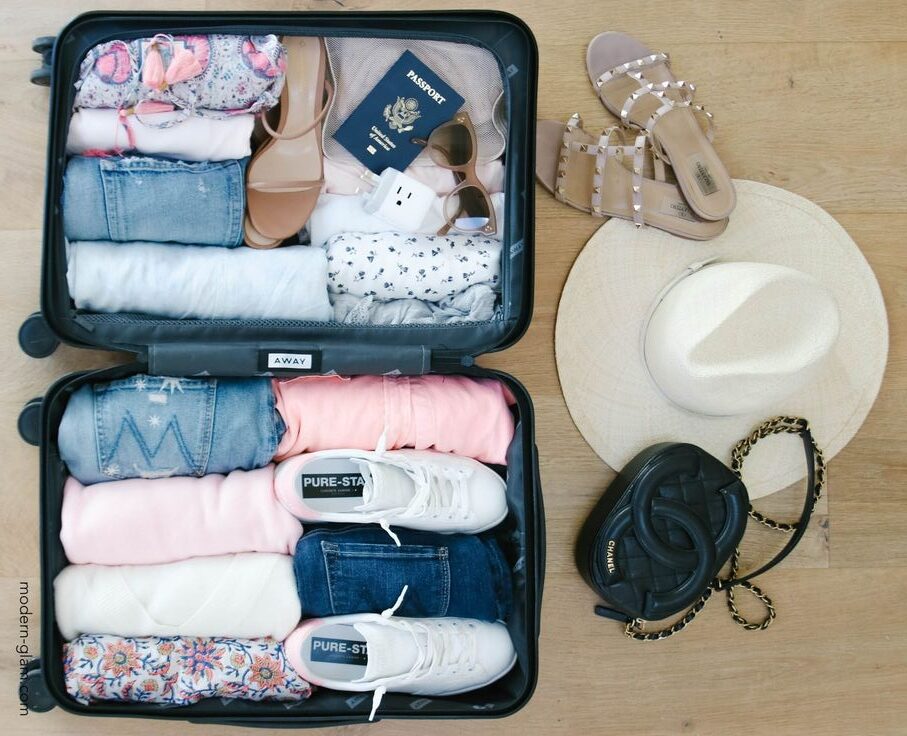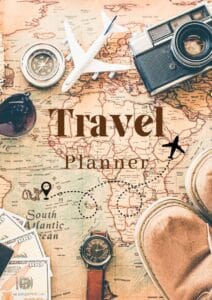Planning a trip should be exciting, not stressful. Whether you’re heading to a tropical beach or a bustling city, having a well-organized travel plan can make all the difference. By following these 7 simple steps, you can ensure a smooth, enjoyable journey without the usual headaches. From setting your destination to packing smartly, these easy-to-follow tips will help you cover all the essentials and make your travel experience as stress-free as possible. Let’s dive into these straightforward steps to create the perfect plan for your next adventure.
Thank you for reading this post, don't forget to subscribe!Travel Plan
Planning a trip can feel overwhelming, but it doesn’t have to be! With a well-organized Travel Plan, you can make your journey stress-free and enjoyable. Start by choosing your destination and setting a budget, so you know what to expect. Next, create a rough itinerary to map out your must-see attractions, but leave room for spontaneity—sometimes the best memories come from unexpected adventures! Don’t forget to book your accommodations and transportation in advance to secure the best deals. Packing efficiently is key, so make a checklist of essentials to avoid last-minute scrambles. As your departure date approaches, confirm all reservations and check travel restrictions. Finally, take a deep breath and remind yourself that the journey is just as important as the destination. With these simple steps, you’ll be well on your way to a memorable trip!
1. Set Your Destination and Dates for Travel Plan

The first step in planning any trip is to figure out where you want to go. Think about places you’ve always wanted to visit, or maybe choose a destination based on the kind of vacation you want—relaxing on a beach, exploring a city, or going on an adventure in nature.
Once you’ve picked your destination, the next step is deciding when to go. Look into the weather during different times of the year—no one wants to plan a beach trip during rainy season! Also, check for local events that might make your trip more exciting or avoid peak seasons when it’s crowded and expensive. By finding the perfect time to visit, you’ll make your trip much more enjoyable and stress-free.
2. Create a Budget

When planning a trip, creating a budget is one of the most important steps to ensure you enjoy your vacation without worrying about overspending. Here’s how to make it simple and stress-free:
- Start with a Total Budget:
- Decide how much money you’re comfortable spending for the entire trip. This is your overall budget, and it will guide all other decisions. Be realistic about what you can afford, including transportation, accommodation, food, and activities.
- Break It Down into Categories:
- Accommodation: Look for places that match your budget, whether it’s a hotel, Airbnb, or hostel. Compare prices and read reviews to get the best value for your money. Remember, location matters—staying closer to attractions might save you money on transportation.
- Food: Research the average cost of meals at your destination. If you’re visiting a place known for street food, you might spend less on meals. For more expensive cities, budget extra for dining out, especially for any special restaurants you want to try. Don’t forget small costs like coffee, snacks, or drinks, as they add up.
- Activities and Entertainment: Make a list of things you want to do and see. Research entrance fees, guided tours, or any special activities like boat rides or concerts. Booking in advance can often save you money, and knowing the costs upfront will help you stay on track.
- Plan for Unexpected Costs:
- It’s always smart to have a little extra money set aside for the unexpected. Maybe you find a cool local experience you didn’t plan for, or you need to take a taxi in a pinch. Emergencies like losing luggage or getting sick could also come with additional costs. Having a cushion in your budget will give you peace of mind during your trip.
- Track Your Spending:
- Keep track of what you’re spending while you travel. You don’t need to document every penny, but checking in regularly will help ensure you’re sticking to your budget. This way, you won’t be caught off guard at the end of your trip with less money than you planned.
By creating a detailed budget and planning for a few surprises, you’ll be able to enjoy your trip without the stress of overspending. It helps you stay in control and focus on making memories instead of worrying about finances!
3. Book Your Transportation

Choosing how to get to your destination is a crucial part of travel planning, and there are a few options to consider: flights, trains, and driving. Each method has its own advantages and can impact your overall trip experience. Here’s a breakdown to help you decide which option is best for you and when to book for the best results.
1. Compare Your Options
Flights: Flying is often the quickest way to get to your destination, especially if you’re traveling long distances or internationally. It’s great for covering large distances in a short amount of time. When booking a flight, consider factors like flight duration, layovers, and overall comfort. For long-haul flights, airlines with better amenities might be worth the extra cost. Use flight comparison websites to find the best deals and read reviews to ensure you’re choosing a reputable airline.
Trains: Train travel can be a scenic and relaxing option. It’s particularly well-suited for medium to long distances, especially in regions with excellent rail networks like Europe or Japan. Trains offer more space to move around and can be more comfortable than budget flights. Some trains even offer sleeping cabins for overnight journeys. Look into different classes of service to find the one that fits your budget and comfort needs. Train travel can also be a more eco-friendly option compared to flying.
Driving: Renting a car or using your own vehicle gives you flexibility and freedom to explore. It’s ideal for shorter distances or road trips where you want to make stops along the way. However, consider the cost of gas, tolls, and parking. Make sure your car is in good condition for the trip, and if you’re renting, check the rental agreement for mileage limits and insurance coverage. Driving also means you’ll need to plan your route carefully to avoid getting lost or encountering road closures.
2. Timing is Key
Book Early: For the best prices and availability, it’s wise to book your transportation as early as possible. Flights and trains often offer lower fares if you book several months in advance. Prices can rise significantly as the departure date approaches, especially during peak travel seasons or busy holidays. Early booking also ensures you get the best choice of seats or accommodations, particularly for popular routes.
Watch for Deals: Keep an eye out for special promotions or discounts. Airlines and train companies frequently offer sales or special deals that can make your trip more affordable. Signing up for fare alerts or newsletters from travel websites can help you stay informed about these offers. Additionally, being flexible with your travel dates and times can help you find cheaper options.
Consider Booking Windows: Different modes of transportation have different optimal booking windows. For flights, booking 2-3 months in advance is usually ideal. For trains, especially in regions with high travel demand, booking 1-2 months ahead is a good rule of thumb. For car rentals, booking as early as possible can help you secure the best rates and availability.
In summary, when booking your transportation, take the time to compare options, consider timing, and plan according to your needs and budget. Whether you choose to fly, take the train, or drive, early planning and thoughtful comparisons will help ensure a smoother and more enjoyable journey.
4. Find Accommodation

Choosing where to stay on your trip can make a big difference in your overall experience. Here’s a simple guide to help you find the perfect place to rest your head:
- Research Your Options: Start by exploring different types of accommodations. Hotels are great if you prefer a more traditional stay with amenities like room service and daily housekeeping. Vacation rentals, such as those found on Airbnb or Vrbo, offer a more home-like experience, often with a kitchen and extra space. Hostels are ideal for budget travelers or those looking to meet new people. Each type has its pros and cons, so think about what fits your needs best.
- Check Reviews: Once you’ve narrowed down your options, look at reviews from previous guests. Websites like TripAdvisor, Google Reviews, and booking platforms often have detailed feedback from travelers. Pay attention to recurring themes in reviews, such as cleanliness, comfort, and the friendliness of the staff. A place with consistently positive reviews is likely to be a good choice.
- Consider the Location: Think about where you want to be during your trip. Is it important to be close to major attractions, public transportation, or the local dining scene? Staying in a central location can save you time and money on transportation. For example, if you’re visiting a city, a hotel or rental in the downtown area might be more convenient than one located in the outskirts.
- Check Amenities: Ensure that the accommodation offers the amenities you need. If you require Wi-Fi, make sure it’s included. If you’re traveling with family, look for a place with enough space and suitable facilities. Sometimes, extra amenities like a pool, breakfast, or airport shuttle can add value to your stay.
- Compare Prices: Finally, compare prices across different booking platforms. Sometimes, booking directly through the hotel or rental’s website can offer better rates or additional perks. Also, look for any hidden fees or extra costs that might not be immediately apparent.
By taking these steps, you can find a comfortable and convenient place to stay, making your trip more enjoyable and stress-free.
5. Plan Activities and Sightseeing

Planning your activities and sightseeing in advance can make a huge difference in your travel experience. Here’s how to go about it:
1. Make a List of Must-See Places and Activities
Start by researching your destination. Look up top attractions, local landmarks, and unique experiences that you wouldn’t want to miss. This could include famous museums, historic sites, beautiful parks, or local festivals.
Think about what interests you the most. Are you a history buff? Check out historical sites and museums. Love the outdoors? Look for parks, hiking trails, or beaches. If you’re into local culture, consider visiting markets or attending local events.
Create a list of these must-see spots and activities. Having a clear idea of what you want to do will help you stay organized and ensure you don’t miss out on anything important.
2. Book Tours or Tickets in Advance
Once you have your list, it’s time to consider how to make the most of your visit. For popular attractions, it’s a good idea to book tours or buy tickets in advance. This can save you from long lines and sold-out situations.
Many popular sights, like museums, amusement parks, or guided tours, often have limited slots and can get crowded quickly. By booking ahead, you can secure your spot and avoid the stress of last-minute planning.
Look for online booking options. Many attractions have their own websites where you can purchase tickets or reserve spots for tours. There are also travel apps and websites that offer tickets and even packages that include several attractions.
Booking in advance not only saves time but can sometimes offer discounts or special deals. It also allows you to plan your days better since you’ll know exactly when you’re visiting each place.
3. Stay Flexible
While planning is important, it’s also good to stay flexible. Unexpected changes or opportunities might come up, so allow some room in your schedule for spontaneity. If you find a local event or a new attraction that wasn’t on your list, you can adjust your plans accordingly.
By taking these steps—making a list of what you want to see, booking in advance, and staying flexible—you’ll be able to enjoy your trip without the stress of last-minute planning. This approach helps ensure that you get the most out of your travels, making your trip memorable and enjoyable.
6. Pack Smart: Your Guide to Stress-Free Packing

Packing for a trip can often feel overwhelming, but with a little organization, you can make it a breeze. Here’s a straightforward guide to packing smart and ensuring you have everything you need for a great trip.
1. Make a Packing List
Start by creating a packing list tailored to your destination and planned activities. Think about the weather—if you’re heading to a sunny beach, you’ll need swimwear, sunscreen, and light clothing. For a winter getaway, pack warm layers, a cozy coat, and waterproof boots. If you’re visiting a city, comfortable walking shoes and a versatile jacket are must-haves.
Consider the activities you’ll be doing. If you plan on hiking, include sturdy shoes and appropriate gear. For a formal event, don’t forget your dressy outfit. A detailed list helps ensure you don’t leave behind anything crucial and keeps you organized as you pack.
2. Pack Efficiently
Once you have your list, it’s time to pack. Start by laying out everything you plan to bring. This makes it easier to see if you have too much or if you’re missing anything. Roll your clothes instead of folding them to save space and reduce wrinkles. Use packing cubes or organizers to keep items separated and easily accessible.
3. Don’t Forget the Essentials
When it comes to essentials, make sure you have the following:
- Travel Documents: This includes your passport (if traveling internationally), flight tickets, hotel reservations, and any necessary visas. Keep these in a secure and easily accessible spot, like a travel wallet.
- Chargers and Electronics: Don’t forget the chargers for your phone, tablet, and any other electronics. If you’re traveling internationally, pack a power adapter suitable for the destination. You might also want a portable charger for on-the-go power.
- Toiletries: Pack the basics such as toothpaste, toothbrush, shampoo, conditioner, and deodorant. Consider travel-sized containers to save space and adhere to airline regulations. If you have specific skincare or health products, include those as well.
4. Pack Smart for Safety
Include a small first-aid kit with band-aids, pain relievers, and any personal medications you might need. Having these items handy can save you from a potential hassle if you need them while on the road.
By following these simple steps, you’ll pack efficiently and ensure that you’re prepared for anything your trip throws at you. Happy packing, and enjoy your stress-free getaway!
7. Prepare for Emergencies
Traveling is exciting, but it’s always wise to be prepared for emergencies. By taking a few simple steps, you can handle unexpected situations with ease and enjoy your trip with greater peace of mind.
1. Get Travel Insurance:
Travel insurance is a safety net that provides financial protection in case things don’t go as planned. Imagine if your flight is canceled, your luggage is lost, or you fall ill while abroad. Without insurance, you could face significant expenses and stress. Travel insurance covers a range of issues, from trip cancellations and interruptions to medical emergencies and lost belongings.
When choosing travel insurance, look for a plan that suits your needs. For instance, if you’re engaging in adventure sports, make sure your policy covers those activities. Review what’s included, such as emergency medical coverage, trip cancellation, and baggage loss. It’s also worth checking if the insurance offers 24/7 assistance, so you have help available anytime you need it.
2. Carry Emergency Contacts and Health Info:
Having the right information at your fingertips can make a big difference in an emergency. Start by compiling a list of important contacts. This should include local emergency services (like police, fire, and medical), the nearest embassy or consulate, and a trusted contact back home. Keep this list in an easily accessible place, such as your phone or a small notebook.
In addition to emergency contacts, make sure you have your health information handy. This includes details about any chronic conditions, allergies, or medications you’re taking. If you have a medical condition, carry a note explaining it in case you need medical assistance. It’s also a good idea to have your doctor’s contact information and any relevant medical records or prescriptions with you.
For added convenience, you can store this information digitally in a secure app or cloud service, ensuring you have access even if you lose your physical documents.
By preparing in advance with travel insurance and having emergency contacts and health info readily available, you’re setting yourself up for a smoother, less stressful travel experience. These precautions help ensure that, no matter what happens, you’re ready to handle unexpected challenges efficiently and effectively. Enjoy your trip, knowing you’ve got a solid plan in place to manage any surprises that come your way.
If you want to read more about the travel click here






